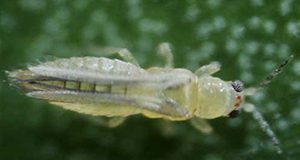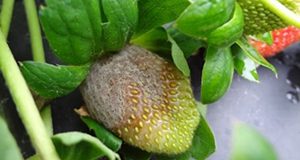Wastewater carries pathogens, nutrients (nitrogen and phosphorus), and trace organic chemicals that may be harmful to human health and ecosystem functioning. Thus, proper treatment of wastewater is crucial. While septic systems can be one means of effective wastewater treatment, there are some special considerations for their use in Florida because of unique geography and sandy soils. The purpose of this new 6-page publication of the UF/IFAS Department of Soil and Water Sciences is to explain the basics of how septic systems work and how they can affect springs water quality in Florida, with a special emphasis on potential N loading from septic systems. This document is intended for homeowners, the general public, and county, city, and other local personnel tasked with managing water quality in areas with septic systems. Written by Mary Lusk, Andrea Albertin, Whitney Elmore, William Lester, and James Moll.
https://edis.ifas.ufl.edu/ss693
Tag: Gulf Coast Research and Education Center
Biology and Management of Pusley (Richardia L.) in Tomato, Pepper, Cucurbit, and Strawberry Production
Four species of pusley (Richardia L.) are widespread and common weeds in Florida vegetable and strawberry production. We refer to the native plant Richardia scabra L. as Florida pusley. This discrimination is necessary because these species are often referred to collectively as Florida pusley due to overlapping distributions, similar growth habits and leaf morphologies, and difficulty identifying without the presence of fruit. This new 6-page publication of the UF/IFAS Horticultural Sciences Department describes the different pusley species and provides management options for strawberry, pepper, cucurbits, and tomato. Written by Shaun M. Sharpe, Nathan S. Boyd, Chris Marble, and Shawn Steed.
https://edis.ifas.ufl.edu/hs1331
Pest Identification Guide: Rugose Spiraling Whitefly, Aleurodicus rugioperculatus
Rugose spiraling whitefly (Aleurodicus rugioperculatus) feeds on over 118 hosts including coconut palm, gumbo limbo, and other fruits and ornamentals. It is a major pest in Florida. Learn to identify these tiny flies with this handy, 2-page guide written by Nicole A. Casuso and Hugh A. Smith and published by the UF/IFAS Entomology and Nematology Department.
http://edis.ifas.ufl.edu/in1202
Pest Identification Guide: Ficus Whitefly Singhiella simplex
Ficuswhitefly (Singhiella simplex) is found on ficus species, especially weeping fig. It is a major pest in Florida. Learn to identify these tiny flies with this handy, 2-page guide written by Nicole A. Casuso and Hugh A. Smith and published by the UF/IFAS Entomology and Nematology Department.
http://edis.ifas.ufl.edu/in1203
Botrytis Fruit Rot or Gray Mold of Strawberry
Botrytis fruit rot (BFR), also known as gray mold, is caused by the fungus Botrytis cinerea and is one of the most important diseases of strawberry in Florida and worldwide. This 4-page document describes the symptoms and management of BFR among strawberry plants. Written by J. C. Mertely, M. S. Oliveira, and N. A. Peres and published by the UF/IFAS Department of Plant Pathology, February 2018.
http://edis.ifas.ufl.edu/pp152
Caladium Cultivars 'Cosmic Delight', 'Fiesta', and 'Hearts Desire'
 Caladiums are commonly grown in containers, hanging baskets, or planted directly in the landscape as accent and border plants. New caladium cultivar introductions are important to the Florida caladium industry, the greenhouse/nursery industries, and commercial landscape maintenance companies. The UF/IFAS Gulf Coast Research and Education Center released three new caladium cultivars, ‘Cosmic Delight’, ‘Fiesta’, and ‘Hearts Desire’, in 2015. This 7-page document describes the characteristics, production potential, and performance of these cultivars. Written by Zhanao Deng and published by the UF/IFAS Environmental Horticulture Department, December 2017.
Caladiums are commonly grown in containers, hanging baskets, or planted directly in the landscape as accent and border plants. New caladium cultivar introductions are important to the Florida caladium industry, the greenhouse/nursery industries, and commercial landscape maintenance companies. The UF/IFAS Gulf Coast Research and Education Center released three new caladium cultivars, ‘Cosmic Delight’, ‘Fiesta’, and ‘Hearts Desire’, in 2015. This 7-page document describes the characteristics, production potential, and performance of these cultivars. Written by Zhanao Deng and published by the UF/IFAS Environmental Horticulture Department, December 2017.
http://edis.ifas.ufl.edu/ep545
Biology and Management of American Black Nightshade (Solanum americanum P. Mill.) in Tomato, Pepper, Cucurbit, and Strawberry
This three-page fact sheet describes the biology and management of American black nightshade, explaining how to control for it in tomato and pepper, cucurbits, and strawberry. Written by Nathan S. Boyd, Shawn Steed, Chris Marble, and Andrew MacRae and published by the Horticultural Sciences Department.
http://edis.ifas.ufl.edu/hs1176
Pest Identification Guide: Western Flower Thrips Frankliniella occidentalis (Pergande)
Western flower thrips transmits the carmovirus Pelargonium flower break virus (PFBV), the ilarvirus Tobacco streak virus (TSV), and the tospoviruses Chrysanthemum stem necrosis virus (CSNV), Groundnut ringspot virus (GRSV), Impatiens necrotic spot virus (INSV), Tomato chlorotic spot virus (TCSV), and Tomato spotted wilt virus (TSWV). This species is primarily a flower feeder, so most damage would be expected on the flower or fruit. Learn to identify the western flower thrips with this two-page illustrated guide written by Jeffrey D. Cluever and Hugh A. Smith and published by the Department of Entomology and Nematology.
http://edis.ifas.ufl.edu/in1127
Pest Identification Guide: Melon Thrips Thrips palmi Karny

Melon thrips transmits Calla lily chlorotic spot virus (CCSV), Groundnut bud necrosis virus (GBNV), Melon yellow spot virus (MYSV), Tomato spotted wilt virus (TSWV), and Watermelon silver mottle virus (WSMoV). This species is primarily a foliage feeder (except in pepper and eggplant, where flowers are more preferred). Feeding on the leaves results in yellowing followed by death of leaf. Leaf feeding can also cause terminal growth to be discolored, stunted, and malformed. Feeding on fruit may cause scarring and malformed fruit. Learn to identify the melon thrips with this two-page illustrated guide written by Jeffrey D. Cluever and Hugh A. Smith and published by the Department of Entomology and Nematology.
edis.ifas.ufl.edu/IN1126
Pest identification Guide: Florida flower thrips Frankliniella bispinosa (Morgan)
The Florida flower thrips is a known pest of blueberry but its status in other crops is unclear. Florida flower thrips transmits Tomato spotted wilt virus and possibly other tospoviruses. This species is primarily a flower feeder, so most damage would be expected on the flower or fruit. Learn to identify the Florida flower thrips with this two-page illustrated guide written by Jeffrey D. Cluever and Hugh A. Smith and published by the Department of Entomology and Nematology.
edis.ifas.ufl.edu/in1125
Pest Identification Guide: Chilli thrips Scirtothrips dorsalis Hood

Chilli thrips transmits the ilarvirus Tobacco streak virus (TSV) and the tospoviruses Groundnut bud necrosis virus (GBNV), Groundnut chlorotic fan-spot virus (GCSFV), and Groundnut yellow spot virus (GYSV). This species primarily feeds on young, tender foliage. Feeding on foliage may result in silvering leading to necrosis, leaf curl (upward), distortion, and defoliation. Feeding on the fruit may cause scarring, discoloration, and the formation of corky texture on the fruit. Learn to identify the chilli thrips with this two-page illustrated guide written by Jeffrey D. Cluever and Hugh A. Smith and published by the Department of Entomology and Nematology.
http://edis.ifas.ufl.edu/in1124
Conservation Reserve Program: Overview and Discussion

The Conservation Reserve Program, a governmental initiative with the goal of protecting the environment by retiring less productive but environmentally sensitive cropland from production, is by far the largest-scale, biggest-budgeted conservation program in the United States. The program has been a success, improving the land allocation of primary crop production and providing environmental benefits, but it is currently confronted with government budget cuts, and some farmers are reluctant to participate. This 5-page fact sheet written by Juhyun Oh and Zhengfei Guan and published by the Food and Resource Economics Department provides an overview of the Conservation Reserve Program and discusses relevant issues for Florida.
http://edis.ifas.ufl.edu/fe973
United States Biofuel Policies: Overview and Discussion

Governments at different levels in the United States have introduced various programs to promote alternative and renewable energies, reduce greenhouse gas emissions, and improve energy security. Some of these policy initiatives include mandates and tax credits to encourage the production of biofuels. As governmental efforts to promote renewable fuels as alternative sources of energy have evolved from subsidization to mandate, the production of biofuels has dramatically increased. The expansion of the mandate may contribute to reducing greenhouse gas emissions, but biofuels may be technically, economically, and environmentally inefficient. This 4-page fact sheet written by Zhengfei Guan and Juhyun Oh and published by the Food and Resource Economics Department reviews and discusses current US biofuel policies and explores potential outcomes.
http://edis.ifas.ufl.edu/fe974
Top Challenges Facing the Florida Strawberry Industry: Insights from a Comprehensive Industry Survey

Florida is the largest supplier of winter strawberries in the United States and the second largest overall after California. The farm-gate value of Florida strawberries is approximately US$400 million and the total economic contribution of the industry is estimated at about US$1 billion. Even so, over the last few years, the Florida strawberry industry has faced many challenges. In 2012, Florida production was down by 20% compared to the previous year. The record level of imports of strawberries from Mexico deeply depressed the market, causing a market crash at the peak season of the Florida production. Decreased revenues coupled with increased production costs have caused significant losses to the Florida industry. In this three-page article, Zhengfei Guan, Feng Wu, and Alicia Whidden investigate Florida growers’ perceptions of various threats and challenges and discuss those threats that should be dealt with as high priority. Published by the UF Food and Resource Economics Department.
edis.ifas.ufl.edu/fe972
An Overview of the US and Mexico Strawberry Industries

The statistics of the Food and Agriculture Organization of the United Nations indicate that world production of strawberries has exceeded 4 million metric tons since 2007. With a total production of 1.4 million tons (3 billion pounds) in 2012, the United States is the largest producer among countries where statistical data are available, accounting for about 30% of the world supply. Production in Mexico increased from 140 thousand tons to 360 thousand tons, making Mexico the second-largest strawberry producer in the world. This four-page fact sheet written by Feng Wu, Zhengfei Guan, and Alicia Whidden and published by the UF Food and Resource Economics Department provides an overview of the US and Mexican strawberry industries, paying special attention to the trade relations between the two countries. (Photo credit: anna1311/istock/Thinkstock)
edis.ifas.ufl.edu/fe971







